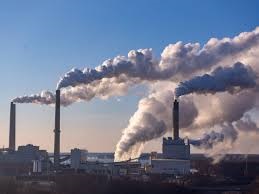India has released a draft framework to set mandatory targets for reducing industrial emissions under the Greenhouse Gases Emissions Intensity (GEI) Target Rules, 2025. The draft, issued by the Ministry of Environment, Forest and Climate Change, is aimed at accelerating India’s commitment to cut emissions intensity of its GDP by 45% by 2030 compared to 2005 levels. These rules will support the Carbon Credit Trading Scheme (CCTS), 2023, creating a structured system for reducing and trading greenhouse gas emissions in energy-intensive industries.
The draft rules are currently open for public comments and suggestions for a 60-day period from the date of notification.

What is Greenhouse Gases Emissions Intensity (GEI)?
Greenhouse Gases Emissions Intensity (GEI) refers to the amount of greenhouse gases (GHGs) emitted per unit of product output. It is usually measured in tonnes of carbon dioxide equivalent (tCO₂e) per unit produced for example, per tonne of cement or aluminium.
GHGs like carbon dioxide, methane, and nitrous oxide contribute to global warming by trapping heat in the atmosphere. The higher the GEI, the more emissions are being generated for the same amount of output. By reducing GEI, industries can lower their climate impact without necessarily cutting overall production a key to sustainable economic growth.
What Do the GEI Target Rules, 2025, Say?
The GEI Target Rules, 2025 introduce mandatory emissions reduction targets for industries with high energy consumption. These include Aluminium, Cement, Chlor-alkali, Pulp & paper.
A total of 282 industrial units fall under the ambit of these rules:
- 13 aluminium plants
- 186 cement plants
- 53 pulp & paper units
- 30 chlor-alkali plants
These targets are based on a baseline year of 2023–24, with reduction targets to be implemented during 2025–26 and 2026–27.
Prominent companies such as Vedanta, Hindalco, Bharat Aluminium, JSW Cement, Ultratech, Nalco, JK Cement, Dalmia Cement, Shree Cement, Grasim Industries, and JK Paper have been identified as “obligated entities” under these rules.
Compliance, Trading and Penalties
The GEI Rules are tied directly to the Carbon Credit Trading Scheme (CCTS) launched in 2023. Here’s how the mechanism works:
- Industries that meet or exceed their emission reduction targets will earn carbon credit certificates.
- These credits can be traded on the Indian Carbon Market, regulated by the Bureau of Energy Efficiency (BEE).
- Non-compliant industries must either buy credits to meet their shortfall or face penalties imposed by the Central Pollution Control Board (CPCB).
- This market-based approach gives companies a financial incentive to cut emissions. Efficient companies can profit from selling credits, while others can phase into greener practices by purchasing them.
Why the Targets Matter
Setting GEI targets is crucial for India’s strategy to achieve low-carbon industrial growth. It allows for sector-specific benchmarks and accountability, and it aligns domestic policy with India’s international obligations under the Paris Agreement.
For instance, a cement manufacturer can reduce its GEI by:
- Switching from coal to biomass or alternative fuels
- Using energy-efficient technologies like advanced kilns
- Capturing waste heat for reuse
The rules also encourage innovation by promoting cutting-edge, sustainable practices in traditionally high-emission sectors.
Conclusion: A Big Step Toward a Greener Future
The Draft Greenhouse Gases Emissions Intensity (GEI) Target Rules, 2025 represent a bold and structured attempt to drive India’s high-emission industries toward sustainable transformation. They provide clarity, incentives, and enforcement mechanisms necessary to support the carbon credit market and meet climate goals.
With the draft rules open for consultation, industry engagement and public feedback will be vital in shaping a fair and effective final policy. If implemented well, these rules could become a model for balancing economic growth with environmental responsibility ensuring that India’s industrial future is both powerful and planet-friendly.
Written by Vaishali Verma
Sub-editor, DisastersNews
